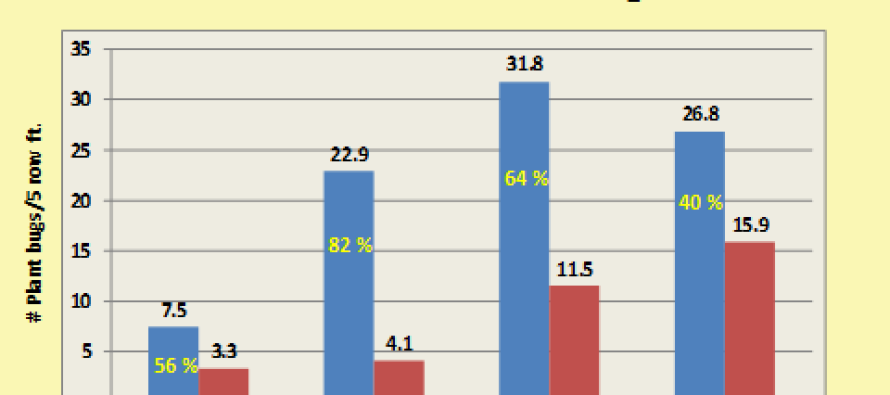Assessing Control of Tarnished Plant Bug in Prebloom Cotton

Tarnished plant bug numbers have actually started off at low to moderate levels this year in the Delta region but just in the last few days numbers seem to be picking up pretty good in a few locations and square retention is not optimal. I have mentioned on numerous occasions the inability to adequately access product performance when you are trying to base it on adult numbers alone. This is because adults will constantly migrate into fields making it difficult to know whether the product is working or it just new adults that have not had time to pick of the product. Consultants and famers also do not have the luxury as we do in research plots to compare to untreated checks. This is why square rentention counts prior to first bloom are criticle. See article (Monitoring Square Retention) .
Basically, if square retention counts are remaining steady, products are working. If they are falling, either numbers are overwhelming treatments or they are not working as well and treatments should be made again. Try and stay above 80% but if you don’t it does not mean you will automatically have yield loss. More likely, the plant will be harder to stop and a little later maturing but it really depends on the fall. If you fall below 80% tighten your threshold and the time between application but I would not go any sooner than 4 days between applications.
Below is an good example of what you might encounter with adults migrating into cotton and how it could be confused with product failures. This is from a real test I conducted in the Delta a few year ago. It was a large plot replicated test sprayed with an airplane 2 times 4 days apart. Remember the drop cloth threshold is 3 plant bugs per 5 row ft., so in the example, we never actually got below threshold. However, 4 days after the first treatment we only achieved 56% control and was still above threshold. We sprayed again and rated 5 days after that. In between the two sprays plant bug numbers exploded from 7.5 to 22.9 in our unsprayed plot. In the treated plots we were still averaging 4.1 plant bugs per 5 row ft. So from one sample to the next after being treated we actually had more plant bugs than we started with. However, we actually got 82% control by making the follow up application then it broke down quickly at 9 and 14 days after treatment as would be expected.
The point of this is….The appearance is there was a complete product failure and that was not the case at all. Square retention counts will help confirm that products are working aside from numbers alone. Be careful to not only look at square retention on field edges or difficult areas for planes to cover.





Let me tell You a sad story ! There are no comments yet, but You can be first one to comment this article.
Write a comment